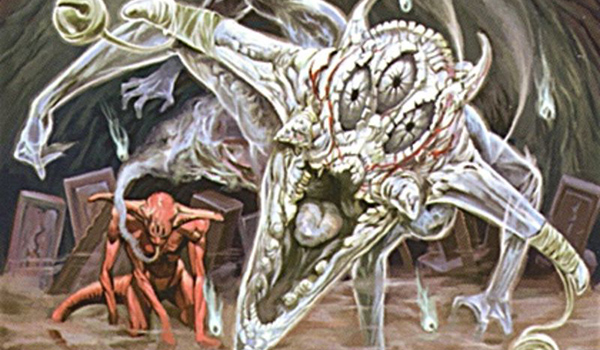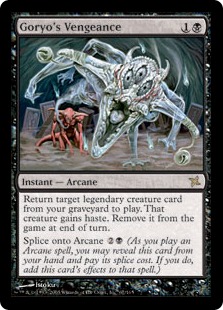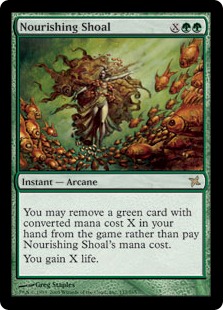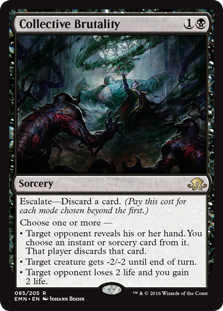Are you a Quiet Speculation member?
If not, now is a perfect time to join up! Our powerful tools, breaking-news analysis, and exclusive Discord channel will make sure you stay up to date and ahead of the curve.
Goryo's Vengeance combo has something of a checkered history in Modern. On the one hand it's a long-time mainstay with the requisite die-hard enthusiasts (and occasional irrational price spikes). On the other hand it struggles to put up consistent results, despite access to a two-mana Yawgmoth's Bargain and its potential for turn two kills. The archetype's biggest success prior to this weekend was an 8-2 finish at Pro Tour Oath of the Gatewatch, in the hands of Kentaro Yamamoto. This weekend Yamamoto doubled up on the deck's high finishes with a Top 8 berth at GP Guangzhou.

Goryo's Vengeance combo, whether in its earlier builds or "Grishoalbrand" variants, has largely been a fringe deck that put up lackluster results. Its breakout performance came during the onset of Eldrazi Winter, when several Japanese pros, including Yamamoto, debuted the innovative Grixis version at Pro Tour Oath. That version sought to trade in the explosiveness and all-in approach of the traditional builds for more interaction and a powerful new discard outlet in Jace, Vryn's Prodigy. Even after this finish (and ample time on camera) the deck put up mediocre showings over the next few months, barely cracking Tier 2 before subsequently falling off the rankings entirely.
I'd be careful reading too much into Yamamoto's "archetype expertise" with Goryo's Vengeance combo, even though it probably was one factor. The reality is that Yamamoto is an absolutely elite world-class player with three Pro Tour Top 8s, two Worlds appearances (including a Top 4 in 2014) and seven GP Top 8s. He's one of those people who could probably win with a cold ham sandwich. That being said, when a player of this caliber elects to pilot a non-tiered deck in two major events, you can't help but sit up and take notice. Here's the list he played in Guangzhou:
[wp_ad_camp_1]
Grixis Goryo's Vengeance, by Kentaro Yamamoto (7th, GP Guangzhou)
First off, some changes from his PT Oath list. The Jaces, which appeared as a full four-of in Atlanta and constituted one of the major innovations of that build, are now completely gone. In their place we see an extra set of cantrips (Sleight of Hand) and 2 copies of Collective Brutality. The sideboard is also radically different, and I'll leave people more familiar with the deck to speculate on the logic there.  The one notable thing is that while Yamamoto cut Thoughtseize from the maindeck, he upped the number of total copies available in the seventy-five to a full playset.
The one notable thing is that while Yamamoto cut Thoughtseize from the maindeck, he upped the number of total copies available in the seventy-five to a full playset.
If you've never seen this deck go off, it shouldn't be hard to glean how it works from the decklist. It's pretty much a textbook case of cheating an undercosted Griselbrand into play and using the Urza's Saga-era degeneracy of that ridiculous card to effectively end the game on the spot. After drawing 14 or more cards (and smacking the opponent for a hearty 7 damage), the Goryo's Vengeance pilot will usually be set up for a kill the following turn, usually in the form of a horrifying spaghetti monster. Through the Breach augments this plan as extra copies of Goryo's Vengeance should you miss on the busted draws or they get answered somehow.
"Grishoalbrand," so named for its prominent use of cross-format-junk-rare Nourishing Shoal, can keep going off the turn you reanimate Griselbrand. Shoal pitching Worldspine Wurm is the name of the game there, which leads to more cards drawn off Griselbrand, more Nourishing Shoals, and so on. The end result is that a substantial amount of the time Grishoalbrand variants kill you the turn they combo off.  Find several Simian Spirit Guides, Manamorphose for black if you don't have an extra land drop available, and Faithless Looting away that Eldrazi titan. Respond to Emrakul, the Aeons Torn's trigger with a second copy of Goryo's Vengeance and swing for 22.
Find several Simian Spirit Guides, Manamorphose for black if you don't have an extra land drop available, and Faithless Looting away that Eldrazi titan. Respond to Emrakul, the Aeons Torn's trigger with a second copy of Goryo's Vengeance and swing for 22.
The cost of this explosiveness is inconsistency and inflexibility. Between Borborygmos Enraged, Worldspine Wurm, and Nourishing Shoal, there are plenty of garbage cards to gum up your hand when you're not comboing. And you can forget trying to interact in any way with an opponent's game plan---just hope you assemble yours faster and don't fall to their disruption. It's not hard to see why this deck hasn't put up great numbers, and it's a great example of how application of the Turn 4 rule in Modern is contingent on deck dominance.
Yamamoto decided these extra accouterments were unnecessary, and trimmed them in favor of more cantrips, disruption, and actual honest-to-god interaction. Izzet Charm and Collective Brutality (and Jace, Vryn's Prodigy before it) are extra discard outlets, while providing meaningful disruption and protecting the combo. Together with the few errant Lightning Bolts, they'll even let you play a miser's control game, buying turns before you combo be removing threats or taking care of something troubling like a Spirit of the Labyrinth.
Collective Brutality in particular seems excellent in this deck, but that's not the only place we've seen it appear. It has also shown up in fair strategies like Jund and Abzan, and I wouldn't be surprised to see this become one of the real breakout gems from Eldritch Moon.  The key to understanding Brutality's power in a format like Modern is what it does for your tempo. It might appear that discarding a card to Duress-plus-Disfigure is merely an unremarkable two-for-two on the card-advantage front. But card advantage in Modern often takes a back seat when decks are trying to outrace each other to their respective combo kills or linear blowouts. Collective Brutality lets you turn less efficient cards into high-octane one-drop spells, all while ensuring fewer dead draws when Thoughtseize or Lightning Bolt don't line up well in the matchup.
The key to understanding Brutality's power in a format like Modern is what it does for your tempo. It might appear that discarding a card to Duress-plus-Disfigure is merely an unremarkable two-for-two on the card-advantage front. But card advantage in Modern often takes a back seat when decks are trying to outrace each other to their respective combo kills or linear blowouts. Collective Brutality lets you turn less efficient cards into high-octane one-drop spells, all while ensuring fewer dead draws when Thoughtseize or Lightning Bolt don't line up well in the matchup.
Finally, I'll bite and comment on those Quicksilver Amulets in the board. My best guess is that this is a strategy for decks that want to grind you out, counter everything, or shut down the graveyard, but it sure looks odd. That's a full eight mana of investment required before they do anything. I'd be interested to hear what Yamamoto's experience with the Amulets was, and whether he believes they merit a spot going forward.
My suspicion is that Goryo's Vengeance won't break open the Modern field anytime soon, even after Yamamoto's finish. It could be that the deck just needs more development, or another impactful printing, to move up the tierings. In any case, I'm not losing any sleep over this one---I'm happy to see a possible turn four violator stay where it belongs in the Tier 3-and-lower dregs.





Collective Brutality is seeing play in multiple modern decks, and Blessed Alliance is helping white. I would not have guessed that Escalate would be a keyword showing up all over. Turns out a cheap discard outlet that does things other than draw cards is pretty good.
I won a PPTQ of 80 people last year with this version, it is not innovative at all…the only thing that keeps the deck far from breaking the format is its inconsistency and the hard skill-cap, otherwise it would be dominant.
My mistake if this version isn’t as new as I thought. My understanding was that earlier versions were straight RB, but it sounds like that isn’t the case. At any rate, it does seem that Jace was a new development, but then he did end up cutting it too.
Inconsistency is a big deal in a seven round event. May as well say it would be dominant if it weren’t for the fact that it isn’t that good.